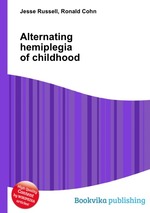Alternating hemiplegia of childhood
Jesse Russell Ronald Cohn
бумажная книга
High Quality Content by WIKIPEDIA articles! Alternating hemiplegia of childhood (AHC) is a rare neurological disorder of uncertain etiology, which is named for the transient episodes, often referred to as attacks, of hemiplegia from which those with the disorder suffer. These hemiplegic attacks can cause anything from mild weakness to complete paralysis on one or both sides of the body, and they can vary greatly in duration. Attacks may also alternate from one side of the body to the other, or alternate between affecting one or both sides during a single attack. AHC is associated with many symptoms besides hemiplegia, and the majority of these become apparent in early infancy. AHC is considered normal if symptoms are present before 18 months of age. Normally, hemiplegia and other associated symptoms cease completely with sleep, but they may recur upon waking. The disorder was only recently discovered, having first been characterized in 1971. AHC is also extremely rare – approximately 1 in 1,000,000 people have this disorder. Besides hemiplegia, symptoms of the disorder include an extremely broad range of neurological and developmental impairments which are not well understood. Much of the literature about AHC is purposefully vague in this respect due to a lack of information on the disorder.


